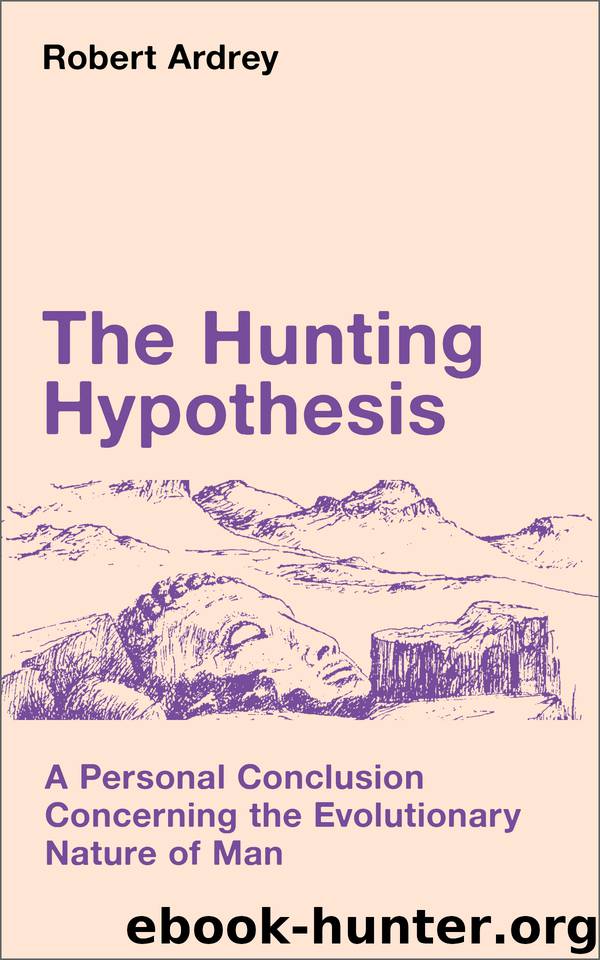The Hunting Hypothesis: A Personal Conclusion Concerning the Evolutionary Nature of Man (Robert Ardrey's Nature of Man series Book 4) by Ardrey Robert

Author:Ardrey, Robert [Ardrey, Robert]
Language: eng
Format: epub
Publisher: STORYDESIGN LTD.
Published: 2014-05-14T16:00:00+00:00
6. The Cultural Animal
A gull called the kittiwake very long ago made what many would describe as a cultural advance. This set in motion a long series of biological adaptations that would never have occurred except for the peculiar nature of the cultural step.
Purists may object to the use of the term culture to refer to any but the achievements of a thinking being capable of choice. Perhaps they are right, even though such purism, to my ear, smacks of anthropocentrism. We have seen in our history how a single cultural step — dependence on a tool called the weapon — brought about, among other biological consequences, the loss of our primate fighting teeth. But I can’t believe that at this remote stage in our evolution such an undoubted cultural acquisition was accomplished by a being who was much of a thinker, or whose new way of life left him much choice.
Whatever my reservations, however, a semantic problem remains. I may regard as a cultural advance any action taken by any animal to modify the environment to suit his needs, in contrast to the normal biological adaptation encouraging changes in the organism to meet environmental demands. Yet that is not how we use the term, so I shall speak of protoculture in reference to animal achievement.
The kittiwake spends most of its life far out at sea, returning to land only for breeding. Defense of the nest and the young has encouraged in most birds a powerful territorial intolerance. Unlike other gulls, who normally nest in large colonies on open ground, the kittiwake found a remarkable ecological niche that offered all but invulnerable natural defense. The kittiwake nests on tiny ledges in cliffs so steep that no one, not even the predatory herring gull, can get at them. The ledges may be as narrow as four inches, the narrower the better. But the nesting sites on such uneven, broken, sometimes crumbling ledges would have been impractical except for the protocultural achievement .
Almost twenty years ago one of Niko Tinbergen’s students at Oxford, Ellen Cullen, studied the kittiwake on certain island cliffs off the Northumberland coast. How she got at them I don’t know, but it is one of the most elegant and significant studies in ethological literature. The kittiwake pair collect mud, grass, roots, and seaweed to make a firm cement. Bringing it to their ledge in their beaks, they slap it on like mortar with sidewise flips of their heads, then trample it flat with their feet. So they extend the ledge where it is too narrow or crumbles away, flatten it where it is too uneven. They finish off their platform with a deep cup from which the eggs cannot roll out.
The biological consequences of this triumph of kittiwake engineering have been almost innumerable. Defense is so perfect that there is no need for camouflage. Among gull species that nest on the open vulnerable ground, for example, the chicks are invariably of a cryptic color difficult to spot if you are a hungry hawk.
Download
This site does not store any files on its server. We only index and link to content provided by other sites. Please contact the content providers to delete copyright contents if any and email us, we'll remove relevant links or contents immediately.
Sapiens: A Brief History of Humankind by Yuval Noah Harari(14321)
Sapiens by Yuval Noah Harari(5325)
Pale Blue Dot by Carl Sagan(4960)
Homo Deus: A Brief History of Tomorrow by Yuval Noah Harari(4873)
Livewired by David Eagleman(3730)
Origin Story: A Big History of Everything by David Christian(3666)
Brief Answers to the Big Questions by Stephen Hawking(3394)
Inferior by Angela Saini(3294)
Origin Story by David Christian(3170)
Signature in the Cell: DNA and the Evidence for Intelligent Design by Stephen C. Meyer(3101)
The Gene: An Intimate History by Siddhartha Mukherjee(3075)
The Evolution of Beauty by Richard O. Prum(2965)
Aliens by Jim Al-Khalili(2803)
How The Mind Works by Steven Pinker(2782)
A Short History of Nearly Everything by Bryson Bill(2663)
Sex at Dawn: The Prehistoric Origins of Modern Sexuality by Ryan Christopher(2500)
From Bacteria to Bach and Back by Daniel C. Dennett(2462)
Endless Forms Most Beautiful by Sean B. Carroll(2444)
Who We Are and How We Got Here by David Reich(2418)
